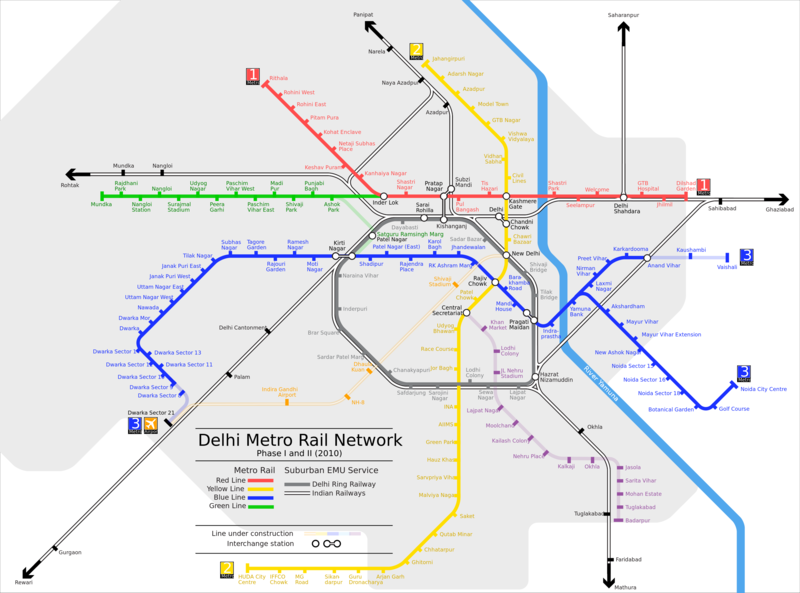The Delhi Metro is a transportation system that operates throughout the city of Delhi and its satellite districts. It is operated by the Delhi Metro Rail Corporation Limited (DMRC), a state subsidiary managed by the central and regional government. The total length is 296.1 kilometers (184 miles), and there are 214 stations divided among 8 lines. The system is also integrated with a line, named the Airport Express, which runs directly to the airport. The official inauguration was December 24, 2002, when the red line began operating. Growth has been sustained, ever since, making it the second largest metro in India. The schedule runs from 6:00 a.m. to 11:00 p.m. and the most basic ticket price is 10 rupees ($US 0.14).
Metros in India: Delhi
New Delhi is the capital of the Republic of India. It is just a fraction of the National Capital Territory of Delhi (NCT), but as a whole, it serves as one of the main cities of the Indian territory.
The city is in the north central part of the country. There are approximately 12 million inhabitants and it is the second most populated city in the country. Including the entire urban area, there is a population of 26 million. The total length is 1484 square kilometers (573 square miles).
This metropolis maintains a large number of traditional structures, which made it a 2014 candidate for UNESCO’s World Heritage City.
The average temperature in the summer is 39°C (89.6°F) and the highest temperature in the winter is 8°C (46.4°F).
The metro
The Delhi Metro route covers 296.1 kilometers (184 miles) within the city and some surrounding areas. It was officially inaugurated on December 24, 2002. The first phase was the red line, consisting of just six stations.
As the years passed, the transportation system expanded its operating radius and grew into one of the country’s most significant metro systems. The models and brands of each train were modified according to each phase. Vehicles from Hyundai Rotem, a company specializing in manufacturing railways, were used during Phase 1. The remaining phases, however, incorporated vehicles from the Canadian company, Bombardier.
The system operator is the public company Delhi Metro Rail Corporation Limited (DMRC). It is estimated that an average of 1 billion riders use the system annually.
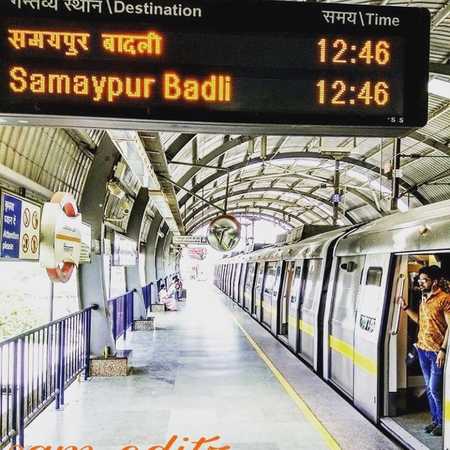 Sikandarpur metro station
Sikandarpur metro station
- Known as: Delhi Metro
- Length: 296.1 kilometers (184 miles)
- Rail width: 1,435 mm (4.71 ft)
- Number of lines: 8
- Number of stations: 214
- Maximum speed: 72 km/h (44.7 m/ph)
- Web site: www.delhimetrorail.com
- Operator: Delhi Metro Rail Corporation Limited (DMRC)
- Daily ridership: 2,760,000
- Founded: December 24, 2002
Brief history
The history of Delhi’s mass transport began in 1969, when the government began a study that revealed the city’s need for the installation of a railway system. However, it wasn’t until 1984, when the Urban Arts Commission presented an integrated transportation system model, which included underground sections. Another 12 years would pass before official metro construction would begin. The government later created the Delhi Metro Rail Corporation (DMRC) subsidiary on May 3, 1995. This company was responsible for revolutionizing the metropolis’ transportation system that had then undergone a state of decline.
Following a new alliance between the state and some private investors, plans for constructing a subway, that could transport everyone in Delhi, were renewed. The metro construction, beginning in 1998, would lead to service on December 24, 2002.
Lines and stations
The Delhi Metro has a total of 8 lines, six of which were installed during Phases 1 and II, while the rest were completed during Phases III and IV. A stand out among the first two phases is the Orange Line, also known as the Airport Express. It provides a direct route to the airport. There is a total of 214 stations, strategically placed within the city and some surrounding areas.
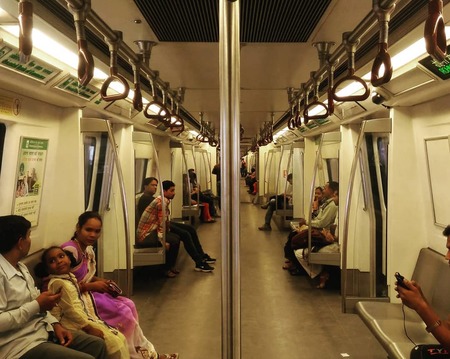
Red Line
The Red Line runs in an east-west direction, with the exception of one portion in the northeast of the city, in which the route runs diagonally. There is a total of 21 stations, which include the terminal stops of Dishad Garden and Rithala. The total journey of this underground route cover 25.1 kilometers (15.6 miles) and its distinguishing color is red.
Yellow Line
This line is a total of 45 kilometers (28 miles), covering the city from north to south. Its distinctive color is yellow, and it is one of the largest and steepest lines in the system. There are 34 stops and the terminal stations are Jahangirpuri and HUDA City Center, located in the nearby city of Gurgaon.
Blue Line
This was the system’s first line. As part of the first phase, it was intended to connect the city’s interior with the surrounding area. There is a total of 56.6 kilometers (35.2 miles) that run through the east-west corridor of the metropolis, until it branches off in the extreme east in which it divides to the north and south respectively. There are 50 stations, whose terminal stops include Dwarka Sector and Noida. The distinguishing color is blue.
Green Line
This is one of the Delhi Metro’s shortest lines, with a length of just 19 kilometers (11.8 miles). The route runs through the city’s east-west corridor, through a total of 18 stations. The terminal stops are Inderlok and Ashok Park Main station. As the name indicates, this line’s distinguishing color is green.
Violet Line
This line runs along the east-west corridor of the city, forming a diagonal like curve. Its 20 kilometers (12.4 miles) include 16 stations. The terminal stations are Central Scretariat and Badarpur. It began operating in 2010.
Orange Line/Airport Express Line
This line is responsible for connecting the city to the closest air terminal, which is the Indira Gandhi International Airport. The total length is 22.7 kilometers (14.1 miles) and it begins in the Dwarka Sector 21 station. Since this line does not have an intermediate stop, it travels 135 km/hr (83.9 mi/hr). The speed is far higher than the other lines, which travel at 80 km/h (49.8 mi/hr). Its distinguishing color is orange.
Magenta Line
The Magenta Line was the first to be inaugurated during the system’s third phase. It officially opened on December 25, 2017. This underground section has a total of 25 stations that extend 28.92 kilometers (18 miles) from Janakpuri West to Botanic Garden station. The line additionally provides a direct connection to the Airport Express Line and as the name suggests, it is characterized by the color magenta.
Pink Line
This is the system’s newest line, and like the magenta line, it was a part of the third phase. Inaugurated on March 14, 2018, the first section runs from Majlis Park to Lajpat Nagar station, covering a total of 12.54 kilometers (7.8 miles). It consists of 38 stations, running from Majilis Park to Shiv Vihar.
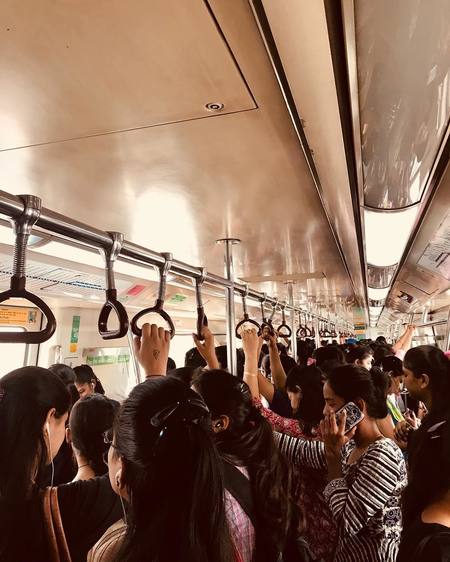 Rajiv Chowk
Rajiv Chowk
Connections to other systems
The Delhi transportation system is strategically designed by the DMRC to make non-metro accessible sites available via buses. 12 bus lines operate within the city. 30 routes are authorized by the state subsidiary and another set of private transportation routes.
Each of the vehicles operated by the state company has a total capacity for 27 passengers altogether, with 18 of the passengers being seated. There are 149 of these buses circulating throughout central Delhi and its neighboring areas. Service is from 6:00 a.m. to 10:00 p.m., with a frequency between stops of 10 to 15 minutes, depending on traffic.
DMRC bus line fares vary according to the distance traveled. The basic 4-kilometer (2.5-mile route is 5 rupees ($US 0.07). The fare is 10 rupees ($US 0.14) if the distance is between 4 (2.5) and 10 kilometers (6.2 miles), and the fare is 15 rupees ($US 0.21) for a distance over 10 kilometers (6.2 miles).
However, other interurban transportation options are available and though they are private, it is important to recognize them for their considerable convenience and popularity. This includes the auto-rickshaws, which are a type of motorized tricycle, available for rent at various city locations, especially near metro stations. They provide a great alternative to dealing with traffic.
Connections to the airport
Located precisely 16 kilometers from Delhi’s center is the Indira Gandhi International Airport, one of the region’s main airport terminals and the country’s most important connection route to the world. With the capacity to serve 12.5 million passengers daily, the air terminal hosts about 7.15 million travelers each day.
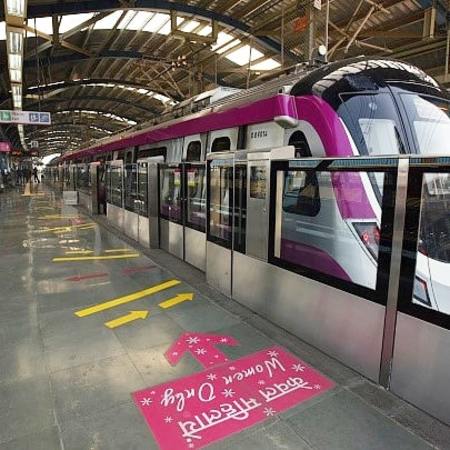 Delhi
Delhi
Although there are private companies managing bus routes from the airport to the city, the Airport Express metro line is the main connection. Also known as the Orange Line, it extends 22.7 kilometers (14.1 miles), of which 15.7 kilometers (9.8 miles) make up the underground section. The remaining is above ground.
This metro section route is elevated from its beginning at Buddha Jayanti Park station to Mahipalpur station, from which it begins to run exclusively underground.
The Airport Express Line connects with several transportation systems. A transfer can be made from New Delhi station to India’s main interstate railway stop or to the metro’s yellow line. The Dhaula Kuan stop provides a direct connection to the pink line. The Delhi Aerocity station connects to Terminal 1 of the bus system, and, lastly the Dwarka Sector 21 stop connects to the blue line.
Schedules and frequency
The Delhi Metro has a continuous schedule that runs from 6:00 a.m. to 11:00 p.m. with slight variations according to the day of the week. Additionally, trains arrive to each stop, about every 8 minutes, with some variation depending on the time of day.
Red Line
The first train departs from Dilshad Garden station at 5:45 a.m. and the last train arrives at Rithala station at 11:20 p.m. Trains operate from 6:00 a.m. to 10:50 p.m. on Saturdays, Sundays, and holidays.
Trains typically arrive every 5 minutes during peak hours. Trains arrive every 13 minutes during non-peak times, weekends and holidays.
Yellow Line
The first train leaves Samaypur Badli station at 5:50 a.m. and the last train reaches Huda City Center station at 11:13 p.m. Trains operate from 6:05 a.m. to 11:00 p.m. on Saturdays, Sundays and holidays.
Trains arrive every 4 minutes during peak hours and every 8 minutes during non-peak hours. The frequency is every 11 minutes on Saturdays, Sundays and holidays.
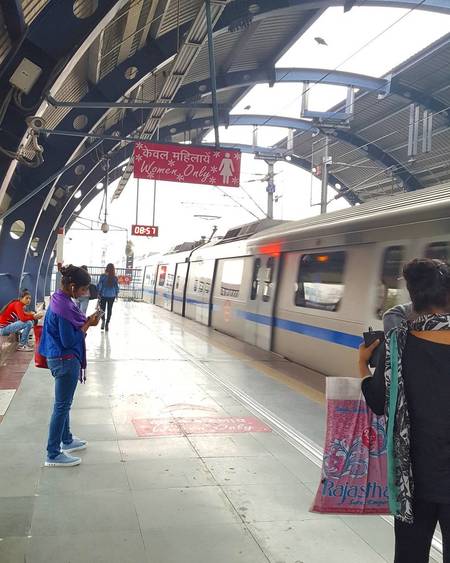 New Delhi metro station
New Delhi metro station
Blue Line
The first train departs from Noida City Center station at 5:40 a.m. and the last train arrives at 11:20 p.m. at Vaishali stop. The departure schedule remains the same on weekends, but service ends at 11:00 p.m.
This line maintains a 3-minute frequency during peak hours and around 8 minutes during non-peak hours. It typically runs every 12 to 13 minutes on Saturdays, Sundays and holidays.
Green Line
Train service begins at 6:05 a.m., with the first train departing from Inderlok station. The last train arrives at Kirti Nagar stop at 11:00 p.m. The schedule is the same for weekends and holidays.
Trains arrive every 5 minutes during peak hours. On Saturdays, Sundays, holidays and during non-peak hours, trains arrive every 13 minutes.
Violet Line
The first train departs from Kashmere Gate station at 6:00 a.m. and the last train reaches Escorts Mujesar station at 11:00 p.m. Service begins at 6:10 a.m. and ends at 10:40 p.m. on Saturdays, Sundays and holidays.
The train for this line typically arrives every 5 minutes during peak hours and every 10 minutes during non-peak hours. Trains arrive every 12 to 13 minutes on Saturdays, Sundays and holidays.
Orange Line
Service on this line runs from 5:50 a.m. to 11:00 p.m. on weekdays, weekends and holidays. This line has the longest wait between stops. Train arrival is every 10 minutes during peak hours and every 18 to 20 minutes during non-peak hours.
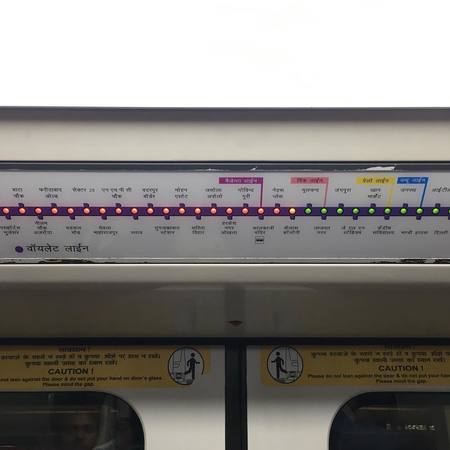 New Delhi
New Delhi
Magenta Line
The first train departs from Botanical Garden station at 6:00 a.m. and the last train arrives at Jankapuri West station at 11:00 p.m. Service runs from 6:10 a.m. to 10:50 p.m. on Saturdays, Sundays and holidays.
The frequency is usually every 6 minutes during peak hours and every 10 minutes during non-peak hours. On Saturdays, Sundays and holidays, the frequency reduces to every 12 minutes.
Pink Line
The Pink Line and Magenta Line schedules are similar. Service on the Pink Line begins at 6:00 a.m. and ends at 10:50 p.m. on weekdays, weekends and holidays. Train frequency is every 7 minutes during peak hours and every 13 minutes during non-peak hours.
Fares, tickets and cards
The Delhi Metro’s ticket and fare system is considerably varied as well as completely automated. Prices are calculated according to the distance traveled, the time spent within the system and the ticket type. The minimum fare for one trip is 10 rupees ($US 0.14) and increases by 10 units for every two consecutive stations. However, this system has the distinction of having a more cost-effective ticket, at 10 units less, during weekends and holidays.
Although the DMRC establishes ticket prices, the fares are not the same as the subsidiary-controlled transportation systems. Subway prices are slightly higher.
The following details the different ticket types and the variations in price.
Tokens: This is Delhi Metro’s simplest payment form. The price is 10 rupees ($US 0.14) and they are good for just one day. They can be purchased at machine dispensers or at the customer care centers, located within each station. Riders receive a reimbursement, if tokens are not used within 60 minutes. Each one is valid for 170 minutes of use. Passengers will be penalized 10 rupees ($US 0.14), if they exceed this time.
Travel and Smart Trip cards: This ticket type is highly recommended for frequent riders. The cost is 150 rupees ($US 2.14) and includes a guaranteed 50-rupee ($US 0.71) refund. It can be reloaded at various system-designated locations with a required minimum of 200 rupees ($US 2.85).
Unlike individual tickets, there is a 10% discount on each trip made with a travel card. Opting to purchase these cards instead of tokens saves a considerable amount of time, since token purchases are quite popular and unlike individual tickets, travel cards allow free movement throughout the system, regardless of the destination or origin.
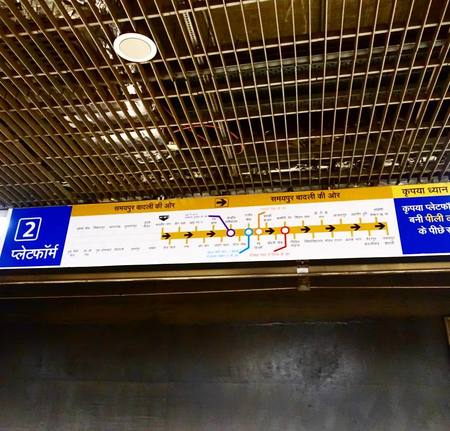 New Delhi
New Delhi
Smart cards are transferable, since they are not personalized. However, they can only be used by one person, once activated at any of the stations. These cards can be reloaded at customer service centers, on ticket machine dispensers, at system-designated selling points and online.
Tourist cards: This ticket is especially designed for temporary city stays. There are two options: the 1-day tourist card and the 3-day tourist card. Both offer unlimited trips on any of the subway lines. The 1-day pass is 200 rupees ($US 2.85) and the 3-day pass is 500 rupees ($US 7.13).
Future expansions
The Delhi Metro is constantly undergoing massive expansions. Also, under Phase IV, is the complete extension implementation of the pink and magenta lines. It is expected that the two will be at optimal operation by the end of 2018.
Also, under construction is the Moss Green Line, which is expected to be complete by 2022. The extension of the red line by more than 100 kilometers (62.1 miles) is expected to be complete by 2022 as well.
Along with the projects already under development, transportation officials are considering implementing Phase V, once Phase IV is complete.
 Malviya Nagar metro station
Malviya Nagar metro station
Tips
- The Delhi Metro is one of the busiest metros in Asia. Therefore, it is recommended to remain alert when using the system and to be especially vigilant of one’s belongings, in order to avoid theft.
- Penalties apply once the designated time in the system is exceeded or when trips, not corresponding to ticket types, are taken. It is, therefore, necessary to review each ticket’s options and follow them accordingly.
- It is essential to ensure that tickets are both purchased and reloaded at officially designated sites.
- The standard written languages for the Delhi Metro are English and Hindi. Therefore, it is recommended to have a basic knowledge of both languages.
Notable facts
- Any ticket type purchased on holidays, Saturdays and Sundays is more economical, by a 10 units reduction.
- There are no reduced fares for children, students or the elderly.
- Children, under 90 centimeters (35.4 inches), may ride free of charge.
- Almost every station has parking for bicycles and vehicles.
- This is the only metro in southern Asia, with a museum that showcases the system’s entire history. It can be found near other major city museums, such as the National and Parliament Museum.
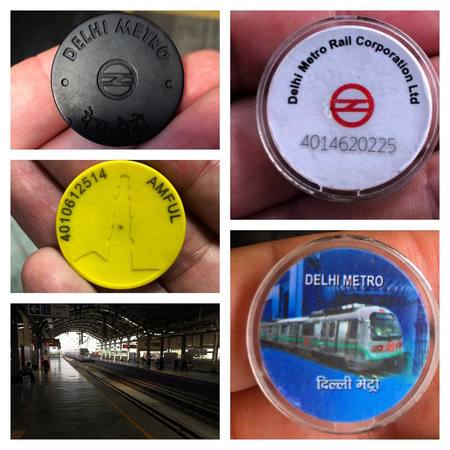
Sightseeing via the Delhi Metro
Delhi is one of the most diverse cities in India. The architectural structures, as well as the concentrations of people, exhibit the city’s truly fascinating diversity. In a matter of minutes, one can journey through modern crowd-filled spaces, cosmopolitan views, and desolate places that solely house grand temples dedicated to serenity and spirituality. The following demonstrates some of the places, both metro accessible and characteristic of Delhi.
Deer Park: This is one the most beautiful natural spaces in the city and serves as one of the most amazing sites for a getaway from the heavily populated city. An ideal spot for a day of rest and relaxation can be found among this park’s many maples, as it includes walking paths, artificial lakes and an abundance of trees. This site is a short walk away from the Magenta Line’s R.K. Puram station.
Central Park: With a countless number of trees and at over 41,500 square meters (446,702 square feet), this is one of the most well-known parks in Delhi. Its flowering plants stand out throughout the year, in addition to its bodies of water, which include a waterfall. This park also contains an amphitheater, popular for its small cultural events. One must simply take the Blue or Yellow Line to Rajiv Chowk station to reach Central Park.
Tibet House: This is one of the city’s most modern and architecturally valuable structures. It functions as a cultural home, which serves as an artistic development space for the region as well as a permanent exposition of Tibet’s heritage and traditions. One must simply get off at the Purple Line’s Khan Market station and travel a few blocks to reach the Tibet House
Delhi metro map
- Passengers/Day 1500000
- Fares: 0.12
- 24h operation: No
- Air Conditioning: Yes
- Walk between platforms: Yes
- Driverless trains: No
- Screen Doors Platforms: No
- Operator: Delhi Metro Rail Corporation Ltd (DMRC)
- Rs. 8.00 - 50.00
- Delhi Metro Official Website
- Tlf: +91 23417910/12
Help us
If you consider that the information we provide is wrong, not accurated, outdated, translation contains errors, and you would like to help us to improve the file...you can contact us here.
Feel free to contact us if you dont find the system you're looking for and we'll add it as soon as we can!
Thank you very much!







